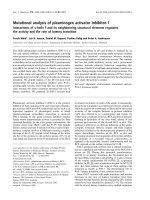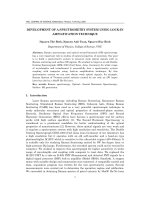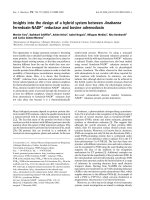1 stability of a linear system
Bạn đang xem bản rút gọn của tài liệu. Xem và tải ngay bản đầy đủ của tài liệu tại đây (304.36 KB, 9 trang )
<span class='text_page_counter'>(1)</span><div class='page_container' data-page=1>
ORF 523 Lecture 10 Princeton University
Instructor: A.A. Ahmadi Scribe: G. Hall
Any typos should be emailed to a a
In this lecture, we consider some applications of SDP:
• Stability and stabilizability of linear systems.
– The idea of a Lyapunov function.
• Eigenvalue and matrix norm minimization problems.
1
Stability of a linear system
Let’s start with a concrete problem. Given a matrixA∈<sub>R</sub>n×n<sub>, consider the linear dynamical</sub>
system
xk+1 =Axk,
where xk is the state of the system at time k. When is it true that ∀x0 ∈ Rn, xk → 0 as
k → ∞? This property calledglobal asymptotic stability (GAS)1<sub>.</sub>
The choice of x = 0 as the “attractor” is arbitrary here. If the system has a different
equilibrium point (i.e., a point where xk+1 = xk) then we could shift it to the origin by an
affine change of coordinates. Stability is a fundamental concept in many areas of science
and engineering. For example, in economics, we may want to know if deviations from some
equilibrium price are forced back to the equilibrium under given price dynamics.
A standard result in linear algebra tells us that the origin of the system xk+1 =Axk is GAS
if and only if all eigenvalues of A have norm strictly less than one; i.e. the spectral radius
ρ(A) of A is less than one. In this, we call the matrixA stable (or Schur stable).
Here we give a different characterization of stable matrices that relates to semidefinite
pro-gramming (SDP) and is much more useful than the eigenvalue characterization when we go
beyond simple stability questions (e.g. “robust” stability or “stabilizability”).
1<sub>The precise definition of global asymptotic stability requires a second condition (the so-called</sub> <sub>stability</sub>
</div>
<span class='text_page_counter'>(2)</span><div class='page_container' data-page=2>
Theorem 1.
The dynamical system xk+1 =Axk is GAS
⇔
∃P ∈Sn×n,s.t. P 0 and P ATP A. (1)
(Note that given A, the search for the matrixP is an SDP.)
Proof: The proof is based on the fundamental concept of a Lyapunov function.
Consider the (Lyapunov) function V(x) =xT<sub>P x. We have</sub> <sub>V</sub><sub>(0) = 0 and</sub> <sub>V</sub><sub>(x)</sub><sub>></sub><sub>0</sub> <sub>∀</sub><sub>x</sub> <sub>6</sub><sub>= 0</sub>
(because of (1)). Condition (1) also implies
V(Ax)< V(x), ∀x6= 0.
In other words, the functionV monotonically decreases along all trajectories of our dynamical
system:
Take anyx0 and consider the sequence{V(xk)}of the functionV evaluated on the trajectory
starting atx0. Since{V(xk)} is nonnegative and lower bounded, it converges to somec≥0.
If c= 0, V(xk) → 0 implies that xk → 0. This is because V is only zero at zero and it is
radially unbounded which implies that its sublevel sets are compact.
It remains to show that we cannot have c >0. Indeed, if c >0, then the trajectory starting
at x0 would forever be contained (because of (1)) in the compact set
</div>
<span class='text_page_counter'>(3)</span><div class='page_container' data-page=3>
Let
δ:= min
x∈S V(x)−V(Ax).
Since the objective is continuous and positive definite and since S is compact, δ exists and
is positive. Therefore, in each iteration V(xk) decreases by at least δ. But this means that
{V(xk)} → −∞which contradicts nonnegativity of V.
To prove the converse, suppose the dynamical system xk+1 = Axk is GAS. Consider the
quadratic function
V(x) =
∞
X
j=0
||Ajx||2
=
∞
X
j=0
xTAjTAjx
=xT
∞
X
j=0
AjTAj
!
x,
which is well-defined since ρ(A) < 1. The function V(x) is clearly positive definite since
even its first term ||x||2 <sub>is positive definite. We also have</sub>
V(Ax)−V(x) =
∞
X
j=1
||Ajx||2<sub>−</sub>
∞
X
j=0
||Ajx||2 <sub>=</sub><sub>−||</sub><sub>x</sub><sub>||</sub>2 <sub><</sub><sub>0.</sub>
Letting P =P∞<sub>j</sub><sub>=0</sub>AjT<sub>A</sub>j<sub>, we have indeed established that</sub><sub>P</sub> <sub></sub><sub>0 and</sub> <sub>A</sub>T<sub>P A</sub><sub>≺</sub><sub>P</sub><sub>.</sub> <sub></sub>
Remark: One can derive the same result in continuous time. The origin of the differential
equation
˙
x=Ax
is GAS iff ∃P ∈Sn×n <sub>s.t.</sub> <sub>P</sub> <sub></sub><sub>0 and</sub> <sub>A</sub>T<sub>P</sub> <sub>+</sub><sub>P A</sub><sub>≺</sub><sub>0. These LMIs imply that</sub> <sub>V</sub><sub>(x) =</sub><sub>x</sub>T<sub>P x</sub>
satisfies ˙V(x) =h∇V(x),x˙i<0, ∀x6= 0.
2
Stabilization with state feedback
</div>
<span class='text_page_counter'>(4)</span><div class='page_container' data-page=4>
concrete problem.
Given matrices A ∈<sub>R</sub>n×n<sub>,</sub><sub>B</sub> <sub>∈</sub>
Rn×k, does there exist a matrixK ∈Rk×n such that
A+BK
is stable; i.e., such that ρ(A+BK)<1?
This is a basic problem in control theory. In the controls jargon, we would like to design a
linear controller u=Kx which is in feedback with a “plant” xk+1 =Axk+Buk and makes
the closed-loop system stable:
xk+1 =Axk+Buk
=Axk+BKxk
= (A+BK)xk.
From our discussion before, A+BK will be stable iff ∃P 0 such that
(A+BK)TP(A+BK)≺P.
Unfortunately, this is not an SDP since the matrix inequality is not linear in the decision
variables P and K. (It is in fact “bilinear”, meaning that it becomes linear if you fix either
P orK and search for the other.)
Nevertheless we are going to show an exact reformulation of this problem as an SDP by
applying a few nice tricks!
Let’s recall our Schur complement theorem first.
Lemma 1. Consider a block matrix X = A B
BT <sub>C</sub>
!
and let S :=C−BT<sub>A</sub>−1<sub>B.</sub>
</div>
<span class='text_page_counter'>(5)</span><div class='page_container' data-page=5>
• X 0⇔A0 and S 0.
In the previous lecture, we proved the first part of the theorem. The proof of the second
part is very similar.
Trick 1: A+BK is stable ⇔AT <sub>+</sub><sub>K</sub>T<sub>B</sub>T <sub>is stable.</sub>
More generally, a matrix E is stable iff ET <sub>is stable. This is clear since</sub> <sub>E</sub> <sub>and</sub> <sub>E</sub>T <sub>have</sub>
the same eigenvalues. It’s also useful to see how the Lyapunov functions for the dynamics
defined byEandET relate. Suppose we haveP 0 andETP E ≺P (i.e.,V(x) =xTP xis a
Lyapunov function forxk+1 =Exk) then by applying the Schur complement twice (starting
from different blocks) we get
ETP E ≺P ⇔
"
P−1 E
ET P
#
0⇔P−1 −EP−1ET 0.
Hence V(x) = xT<sub>P</sub>−1<sub>x</sub> <sub>is our desired Lyapunov function for the dynamics</sub> <sub>x</sub>
k+1 = ETxk.
Note thatP−1 <sub>exists and is postiive definite as eigenvalues of</sub><sub>P</sub>−1 <sub>are the reciprocal </sub>
eigenval-ues of P.In summary, we will instead be looking for a Lyapunov function for the dynamics
defined by AT <sub>+</sub><sub>K</sub>T<sub>B</sub>T<sub>.</sub>
Trick 2: Schur complements again.
We have
P −(AT +KTBT)TP(AT +KTBT)0
m
"
P P(AT +KTBT)
(AT <sub>+</sub><sub>K</sub>T<sub>B</sub>T<sub>)</sub>T<sub>P</sub> <sub>P</sub>
#
0
m
"
P P AT +P KTBT
AP +BKP P
#
0.
Trick 3: A change of variables.
Let L=KP. Then we have
"
P P AT <sub>+</sub><sub>L</sub>T<sub>B</sub>T
AP +BL P
#
</div>
<span class='text_page_counter'>(6)</span><div class='page_container' data-page=6>
This is now a linear matrix inequality (LMI) in P and L! We can solve this semidefinite
program for P and L and then we can simply recover the controller K as
K =LP−1.
3
Stabilization with output feedback
Here is another concrete problem of similar flavor.
Given matrices A ∈ <sub>R</sub>n×n<sub>, B</sub> <sub>∈</sub>
Rn×k, C ∈ Rr×n, does there exist a matrix K ∈ Rk×r such
that
A+BKC
is stable, i.e., such that ρ(A+BKC)<1?
The problem is similar to the previous one, except that instead of feeding back the full
state x to the controller K, we feeback an output y which is obtained from a (possibly
non-invertible) linear mappping C from x. For this reason, the question of existence of a
K that makes the closed-loop system (i.e., A+BKC) stable is known as the “stabilization
with output feedback” problem.
Can this problem be formulated as an SDP via some “tricks”? We don’t know! In fact,
the exact complexity of this problem is regarded as a “major open problem in systems and
control theory” [2].
</div>
<span class='text_page_counter'>(7)</span><div class='page_container' data-page=7>
then Blondel and Tsitsiklis [3] have shown that the problem is NP-hard. In absence of these
constraints, however, the complexity of the problem is unknown.
You will deservingly receive an A in ORF 523 if you present a polynomial-time algorithm
for this problem or show that it is NP-hard.
4
Take-away message
It is not always obvious to determine whether a problem admits a formulation as a
semidef-inite program. A problem which looks non-convex in its original formulation can sometimes
be formulated as an SDP via a sequence of transformations. In recent years, a lot of
re-search has been done to understand these transformations more systematically. While some
progress has been made, a complete answer is still out of reach. For example, we do not
cur-rently have a full answer to the following basic geometric question: Under what conditions
can a convex set be written as the feasible set of an SDP or the projection of the feasible set
of a higher dimensional SDP?
5
Eigenvalue and matrix norm optimization
Semidefinite programming is often the right tool for optimization problems involving
eigen-values of matrices or matrix norms. This is hardly surprising in view of the fact that positive
semidefiniteness of a matrix has a direct characterization in terms of eigenvalues.
5.1
Maximizing the minimum eigenvalue
Let A(x) =A0+
Pm
i=0xiAi, whereAi ∈Sn×n are given. Consider the problem
max.
x λminA(x).
This problem can be written as the SDP
max.
x,t t
s.t. tI A0+
X
i
xiAi
This is simply because for a general matrix B ∈Sn×n <sub>we have the relation</sub>
</div>
<span class='text_page_counter'>(8)</span><div class='page_container' data-page=8>
for the ith <sub>eigenvalue</sub> <sub>λ</sub>
i. This is equally easy to see from the definition of eigenvalues as
roots of the characteristic polynomial.
5.2
Minimizing the maximum eigenvalue
Similarly with A(x) defined as before, we can formulate the problem
min.
x λmaxA(x)
as the SDP
min.
t,x t
s.t. A(x)tI.
Question for you:
Can we minimize the second largest eigenvalue of A(x) using SDP?
(Hint: Convince yourself that if you could do this, you could find for example the largest
independent set in a graph using SDP.
Hint on the hint: write the problem as an SDP with a rank-1 constraint.)
5.3
Minimizing the spectral norm
Given A0, A1, . . . , Am ∈ Rn×p, let A(x) := A0 +
Pn
i=1xiAi and consider the optimization
problem
min
x∈Rm
||A(x)||.
Here, the norm ||.||is the induced 2-norm (aka the spectral norm). We have already shown
that ||B||=pλmax(BTB) for any matrix B.
</div>
<span class='text_page_counter'>(9)</span><div class='page_container' data-page=9>
So our problem is
min.
t,x t
s.t. ||A(x)||2 <sub>≤</sub><sub>t</sub>
m
min.
t,x t
s.t. AT(x)A(x)tIp
m
min.
t,x t
s.t.
"
In A(X)
AT(x) tIp
#
0.
This is an SDP.
Practice: With A(x) defined as before, formulate the minimization of the Frobenius norm as
an SDP:
min.
x∈<sub>R</sub>m||A(x)||F.
Notes
Further reading for this lecture can include Chapter 4 of [1] and chapters 2 and 9 of [4].
References
[1] A. Ben-Tal and A. Nemirovski. Lectures on Modern Convex Optimization: Analysis,
Algorithms, and Engineering Applications, volume 2. SIAM, 2001.
[2] V. Blondel, M. Gevers, and A. Lindquist. Survey on the state of systems and control.
European Journal of Control, 1(1):5–23, 1995.
[3] V. Blondel and J.N. Tsitsiklis. NP-hardness of some linear control design problems.
SIAM Journal on Control and Optimization, 35(6):2118–2127, 1997.
</div>
<!--links-->









